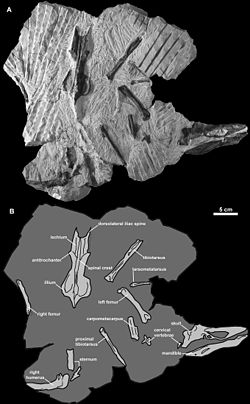Miomancalla
| Mancallines Temporal range: Miocene – , 7.4–4.7 Ma |
|
|---|---|
 |
|
| Holotype of Miomancalla howardi | |
| Scientific classification | |
| Kingdom: | Animalia |
| Phylum: | Chordata |
| Class: | Aves |
| Order: | Charadriiformes |
| Clade: | Pan-Alcidae |
| Clade: |
†Mancallinae L. Miller, 1946 |
| Type species | |
|
Mancalla californiensis Lucas, 1901 |
|
| Genera | |
Praemancalla
Mancalla
Miomancalla
The Mancallinae were a group of prehistoric flightless auk relatives that lived on the Pacific coast of today's California and Mexico from the late Miocene epoch to the early (ranging from at least 7.4 million to 470 thousand years ago). They are sometimes collectively referred to as Lucas auks after the scientist who described the first species, Frederic Augustus Lucas.
They had evolved along somewhat similar lines as the great auk, their North Atlantic ecological counterpart, but their decidedly stubbier wings were in some aspects more convergent with penguins.
Compared with the subarctic great auk, they were also smaller (see also: Bergmann's Rule): Praemancalla species have been estimated to have weighed about 3 kg. Most Mancalla forms weighed somewhat less (about 2.4 kg), with M. milleri being a smaller (1.65 kg) and M. emlongi a much larger bird (3.8 kg) than the rest. The last species thus stood around 55–60 cm high in life. The largest species, Miomancalla howardi, was the largest charadriiforme of all time.
In a 2011 paper, N. Adam Smith published a review and revision of the Mancallinae. Smith defined Mancallinae as the clade containing Mancalla, Miomancalla, their common ancestor and all its descendants. A summary of his results follows.
The following species could not be identified as unquestionable mancallines, and have been assigned to Pan-Alcidae incertae sedis. They may be mancallines, or more closely related to true auks.
...
Wikipedia
